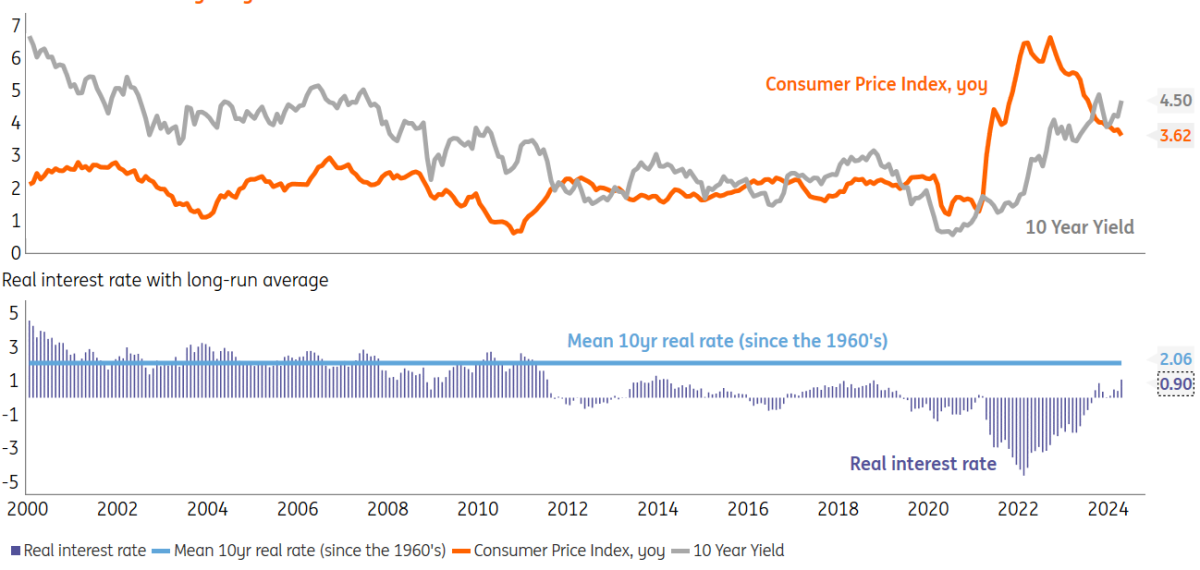Let’s get real on US rates
The 10yr yield you see on your screen today at 4.5% feels high as its come from very low levels, and indeed is well above the 15yr average. But, forget the past decade-and-a-half for anchor points, as that was not normal. We show in fact that 4.5% is neutral. We can get down to 4% in a rate-cutting phase, but we rationalise why we’ll in fact end back up at 5%
The US 10yr at 4.5% is at a neutral valuation, even if inflation falls (as real yield should be higher)
We’ve noted that the 10yr Treasury yield is at risk for a trek towards 5% for as long as 0.3% month-on-month (or higher) readings are being printed for CPI and PCE. But the latest Core PCE deflator came in at 0.2% MoM. A run of these can ultimately prompt the Fed into cutting. So, where are we now for the 10yr yield?
First, note our theory that the noughties offered a valid vision of an “average neutral environment”. That decade saw US inflation average around 2½ percent, and coincided with an average Fed funds rate of 3 percent and an average 10yr Treasury yield of around 4½ percent. See more here.
Based off this, if we are to have a soft landing and contained inflation, the funds rate should not go below 3%. That sets the ultimate floor. That floor can be set higher, say in the 4% area, should some inflation vulnerabilities persist. This is all relevant for setting where the 10yr yield can get to.
Our noughties analysis suggests an equilibrium 10yr yield at around 4.5%, and that in fact factors in a funds rate bottom at 3%. A higher funds rate bottom can easily pressure the 10yr above 4.5%. Basically the current 10yr yield is not necessarily representing glaring value, even if inflation falls.
The US 10yr real rate is still only 1%. The neutral level is 2%. Lower CPI does not necessarily mean lower yields...

Rate cutting can see an overshoot to the downside to the 4% area on the 10yr
In addition, we note that the average 10yr real yield since the 1960’s is around 2%. It’s now around 1% (based off printed inflation rates). If we assume a return to “normal rates” (and we do) then we should be looking for a 2% real rate in the 10yr tenor. See the chart above.
If inflation falls by 1%, that will bring a 2% real rate. However, that leaves the 10yr Treasury yield unchanged. This is important, as it highlights the fact that the 10yr Treasury yield does not necessarily have a valid reason to fall simply based off the notion that inflation falls.
But here’s why the 10yr Treasury yield can fall:
Rate cutting typically coincides with falls in longer tenor yields. See here for more; it shows significant falls are typical pre and post the first cut. Based off that, if the Fed were to start to cut in the coming months, a move to 4% (or below) for the 10yr Treasury yield would not be atypical.
In fact, we are calling for a bullish move like this. It will bring with it a rationale for asset managers to get tactically long at an early phase (before the first cut), and for liability managers to either issue or lock in rates at a later phase (after the first few cuts). That window, though, we think will be short (no more than a few months), and will end well before the Fed has completed its rate-cutting cycle.
In the end 5% remains a level for the 10yr that's still in the conversation
However, the 10yr Treasury yield at 4% (or below) is not an equilibrium outcome, as rate cutting will coincide with the build of a positive yield curve. A normal (average) noughties style curve would encompass a 150bp term premium in the 10yr yield.
That quickly pitches the 10yr back at 4.5%. And if the funds rate fails to get back down to 3%, and say bottoms at 4%, then we can quickly see a rationale for a 5% 10yr yield. Factor in fiscal / issuance pressure and we can also get to the 5% level, even off a 3% funds floor.
Bottom line, the 4.5% 10yr yield we see today is neither high nor low. It’s bang on what we deem neutral. Equilibrium is a big word, but it's right here in our opinion. Even if inflation falls, the 10yr real yield is so low that it has no right to fall simply based off that.
The key element is rate cutting, as that typically pulls down longer tenor rates. We’ll get down to 4% on the 10yr as the Fed rate cutting discount hardens and the Fed kicks off with cuts.
But that's an overshoot to the downside. So, barring a systemic crash, don’t expect to stay there. Add in additional fiscal drivers and a 5% handle looks more fair (above normal), post the early phases of rate cutting.
Hence, the more natural medium-term outcome is for the 10yr yield to have a tendency to settle far closer to 5% than 4%.
This publication has been prepared by ING solely for information purposes irrespective of a particular user's means, financial situation or investment objectives. The information does not constitute investment recommendation, and nor is it investment, legal or tax advice or an offer or solicitation to purchase or sell any financial instrument. Read more
Download
Download opinion
Padhraic Garvey, CFA
Padhraic Garvey is the Regional Head of Research, Americas. He's based in New York. His brief spans both developed and emerging markets and he specialises in global rates and macro relative value. He worked for Cambridge Econometrics and ABN Amro before joining ING. He holds a Masters degree in Economics from University College Dublin and is a CFA charterholder.
Padhraic Garvey, CFA
